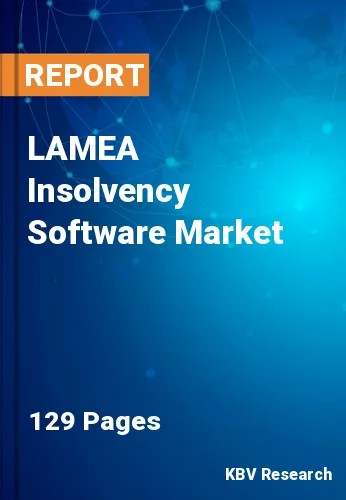The Latin America, Middle East and Africa Insolvency Software Market would witness market growth of 14.8% CAGR during the forecast period (2023-2030).
Market demand and customer expectations play a crucial role in steering innovation within the software landscape. Manufacturers keenly observe their clientele's shifting needs and preferences, leveraging market insights to tailor their software offerings accordingly. Customer feedback and industry trends serve as valuable inputs, driving manufacturers to develop and integrate features that address specific pain points, enhance user experience, and streamline complex tasks. This customer-centric approach to innovation ensures that software solutions remain relevant, intuitive, and aligned with the practical requirements of insolvency practitioners and stakeholders.
The interconnectedness of financial sectors have amplified the complexities of insolvency proceedings. Major manufacturers in the market recognize the significance of offering versatile and scalable solutions that cater to a diverse array of jurisdictions and regulatory frameworks. The ability to provide software that accommodates varying legal landscapes and international best practices is a key driver of innovation. Manufacturers invest in developing adaptable platforms capable of addressing the intricacies of cross-border insolvency cases, thereby expanding their market reach and relevance.
There's a growing awareness among businesses in the Middle East regarding the importance of risk management and compliance. Cultural shifts toward a proactive approach to financial health and crisis management drive the adoption of the software tools. Nations like Qatar, UAE, Saudi Arabia, Egypt, and Oman have recently updated their insolvency frameworks. For example, Qatar has proposed a new Bankruptcy Law to modernize its insolvency framework. The proposed law aims to provide a legal framework for reorganization, debt restructuring, and protection for businesses facing financial challenges, encouraging a more systematic approach to handling insolvency cases. Thus, the region presents lucrative growth opportunities for the market.
The Brazil market dominated the LAMEA Insolvency Software Market by Country in 2022, and would continue to be a dominant market till 2030; thereby, achieving a market value of $71.2 million by 2030. The Argentina market is showcasing a CAGR of 15.4% during (2023 - 2030). Additionally, The UAE market would register a CAGR of 14.5% during (2023 - 2030).
Based on Component, the market is segmented into Solution, and Services (Professional Services, Managed Services). Based on Organization Size, the market is segmented into Large Enterprises, Small & Medium Enterprises. Based on Application, the market is segmented into Document Management, Financial Transaction Management, Reporting, Compliance, Creditor Management, and Others. Based on Vertical, the market is segmented into BFSI, Manufacturing, IT & Telecom, Energy & Utilities, Government, Retail, and Others. Based on countries, the market is segmented into Brazil, Argentina, UAE, Saudi Arabia, South Africa, Nigeria, and Rest of LAMEA.
Free Valuable Insights: The Worldwide Insolvency Software Market is Projected to reach USD 3 Billion by 2030, at a CAGR of 10.3%
The market research report covers the analysis of key stake holders of the market. Key companies profiled in the report include Themis Solutions Inc. (Clio), Aryza Ltd. (Macquarie Group Limited), Stretto, Inc., Epiq Systems, Inc. (OMERS Private Equity Inc.), Kroll, LLC, Turnkey Computer Technology Ltd, Panther Software, LLC, Fastcase, Inc. (vLex, LLC), Standard Legal Network, LLC and LegalPRO Systems, Inc.
By Component
By Organization Size
By Application
By Vertical
By Country
Our team of dedicated experts can provide you with attractive expansion opportunities for your business.

